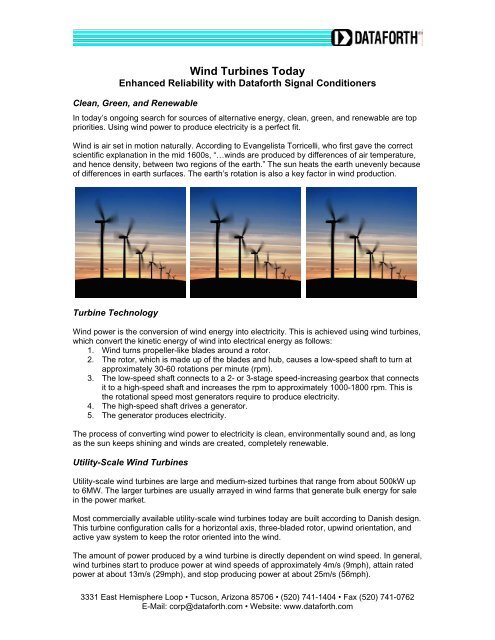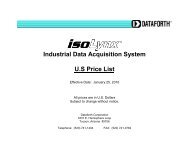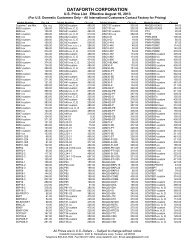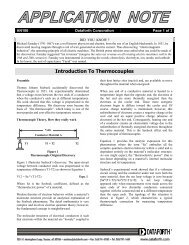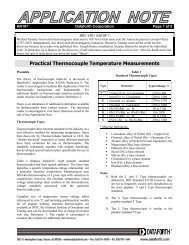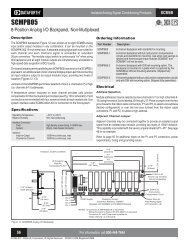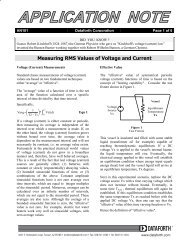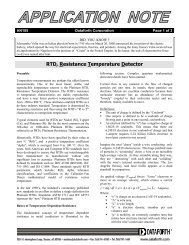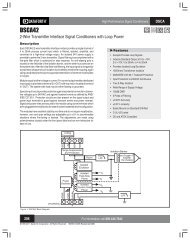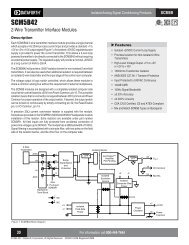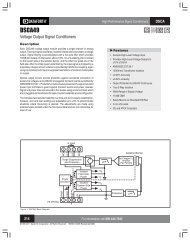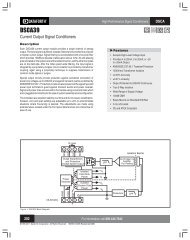Wind Turbines Today - Dataforth
Wind Turbines Today - Dataforth
Wind Turbines Today - Dataforth
Create successful ePaper yourself
Turn your PDF publications into a flip-book with our unique Google optimized e-Paper software.
<strong>Wind</strong> <strong>Turbines</strong> <strong>Today</strong>Enhanced Reliability with <strong>Dataforth</strong> Signal ConditionersClean, Green, and RenewableIn today’s ongoing search for sources of alternative energy, clean, green, and renewable are toppriorities. Using wind power to produce electricity is a perfect fit.<strong>Wind</strong> is air set in motion naturally. According to Evangelista Torricelli, who first gave the correctscientific explanation in the mid 1600s, “…winds are produced by differences of air temperature,and hence density, between two regions of the earth.” The sun heats the earth unevenly becauseof differences in earth surfaces. The earth’s rotation is also a key factor in wind production.Turbine Technology<strong>Wind</strong> power is the conversion of wind energy into electricity. This is achieved using wind turbines,which convert the kinetic energy of wind into electrical energy as follows:1. <strong>Wind</strong> turns propeller-like blades around a rotor.2. The rotor, which is made up of the blades and hub, causes a low-speed shaft to turn atapproximately 30-60 rotations per minute (rpm).3. The low-speed shaft connects to a 2- or 3-stage speed-increasing gearbox that connectsit to a high-speed shaft and increases the rpm to approximately 1000-1800 rpm. This isthe rotational speed most generators require to produce electricity.4. The high-speed shaft drives a generator.5. The generator produces electricity.The process of converting wind power to electricity is clean, environmentally sound and, as longas the sun keeps shining and winds are created, completely renewable.Utility-Scale <strong>Wind</strong> <strong>Turbines</strong>Utility-scale wind turbines are large and medium-sized turbines that range from about 500kW upto 6MW. The larger turbines are usually arrayed in wind farms that generate bulk energy for salein the power market.Most commercially available utility-scale wind turbines today are built according to Danish design.This turbine configuration calls for a horizontal axis, three-bladed rotor, upwind orientation, andactive yaw system to keep the rotor oriented into the wind.The amount of power produced by a wind turbine is directly dependent on wind speed. In general,wind turbines start to produce power at wind speeds of approximately 4m/s (9mph), attain ratedpower at about 13m/s (29mph), and stop producing power at about 25m/s (56mph).3331 East Hemisphere Loop • Tucson, Arizona 85706 • (520) 741-1404 • Fax (520) 741-0762E-Mail: corp@dataforth.com • Website: www.dataforth.com
As wind speeds increase with height above the earth, wind turbines are mounted on high towersof approximately 100 feet (30 meters) or more to ensure access to more wind energy.<strong>Wind</strong> Turbine Safety and Control<strong>Wind</strong> turbine control and safe operation are key concerns when using wind power. Unlike virtuallyevery other industry, wind turbines operate without direct supervision. Components are mountedat the top of the tower, where six months may go by between regularly scheduled maintenanceoperations. In the meantime, rotating components are generating vibration and heat that cancause parts to malfunction and fail.As an antidote to these issues, <strong>Dataforth</strong> Corporation’s SCM5B, SCM7B, and SensorLex ® 8Bsignal conditioning modules are all fully encapsulated, thereby ensuring they are corrosionresistant and well suited for use in rugged environments. In addition to encapsulated conditioners,<strong>Dataforth</strong> offers rugged, non-encapsulated products that could be applicable as well. Theseinclude DSCA DIN rail mount isolated signal conditioners, DSCT DIN rail mount 2-wiretransmitters, and DSCL loop isolators.Inside a <strong>Wind</strong> Turbine3331 East Hemisphere Loop • Tucson, Arizona 85706 • (520) 741-1404 • Fax (520) 741-0762E-Mail: corp@dataforth.com • Website: www.dataforth.com


